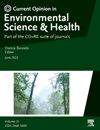古生态毒理学的新进展:应用湖泊沉积物档案评估水生污染影响的新方法
IF 6.6
Q1 ENVIRONMENTAL SCIENCES
Current Opinion in Environmental Science and Health
Pub Date : 2025-09-06
DOI:10.1016/j.coesh.2025.100667
引用次数: 0
摘要
许多水生生态系统都经历过暴露于环境污染物的影响,水生生物群在暴露于有毒物质后往往表现出种群和/或群落的变化。然而,由于监测数据的缺乏和监测记录的空白,确定水生影响可能具有挑战性。湖泊沉积物作为自然环境档案(古湖泊学)的研究为评估污染对水生生物和生态系统的长期影响提供了机会。从污染系统中收集的岩心既可以保存有关有毒物质的记录,也可以保存从分子水平到群落到生态系统过程等多个组织尺度上生物变化的档案(古生态毒理学)。在此,我们回顾了基于“经典”古湖泊污染指标(如金属、有机污染物)和生态毒理学响应变量(如色素和亚化石形态指标)的古生态毒理学方法的最新应用实例。我们还概述了越来越多地在沉积物记录中被检测和记录的新出现的环境污染物(例如微塑料,药物),强调了毒理学压力源的演变来源和强度,这是未来古生态毒理学研究的成果领域。此外,利用新兴的沉积DNA方法表征水生群落变化的能力已经迅速扩大,为建立从传统指标获得的生态信息提供了强大的机会,以更好地了解生态系统对污染的响应。最后,我们通过探索最近的几个例子,论证了在古生态毒理学方法的未来应用中,专门研究污染的生态毒理学影响的方法学方法的重要性。本文章由计算机程序翻译,如有差异,请以英文原文为准。
New developments in paleo-ecotoxicology: Emerging approaches in applying lake sediment archives to assess impacts from aquatic pollution
Many aquatic ecosystems have experienced a history of impacts from exposure to environmental contaminants, with aquatic biota often exhibiting population and/or community changes following toxicant exposure. However, identifying aquatic effects can be challenging due to a paucity of monitoring data and gaps in monitoring records. The study of lake sediments as natural environmental archives (paleolimnology) provides an opportunity to assess the long-term impacts of pollution on aquatic organisms and ecosystems. Cores collected from polluted systems can preserve both a record of the toxicant(s) in question, and also an archive of biotic changes at multiple scales of organization, from molecular levels to communities to ecosystem processes (paleo-ecotoxicology). Here, we review recent examples of the application of the paleo-ecotoxicological approach based on ‘classical’ paleolimnological indicators of contamination (e.g. metals, organic contaminants) and ecotoxicological response variables (e.g. pigments and subfossil morphological indicators). We also outline emerging environmental contaminants (e.g. microplastics, pharmaceuticals) that are increasingly being detected and documented in sediment records, highlighting evolving sources and intensities of toxicological stressors that are fruitful areas for future paleo-ecotoxicological inquiry. In addition, the ability to characterize aquatic community changes using emerging sedimentary DNA approaches has rapidly expanded, providing a powerful opportunity to build on the ecological information obtained from traditional indicators to better understand ecosystem responses to contamination. Finally, we argue for the importance of methodological approaches that specifically examine the ecotoxicological impacts of contamination in the future application of the paleo-ecotoxicological approach by exploring several recent examples.
求助全文
通过发布文献求助,成功后即可免费获取论文全文。
去求助
来源期刊

Current Opinion in Environmental Science and Health
Medicine-Public Health, Environmental and Occupational Health
CiteScore
14.90
自引率
0.00%
发文量
92
审稿时长
114 days
 求助内容:
求助内容: 应助结果提醒方式:
应助结果提醒方式:


